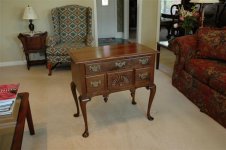I have a couple of questions regarding cutting the three tenons on each end of the side piece for a Q/A dressing table. The side piece is 13/16"Thk x 14"H x 14"L plus 3/4" on each end for the tenons.
First, does anyone have any suggestions for sawing that 14" long shoulder? I've never attempted one this long. I'm thinking I'll probably clamp a guide board along the scribe line and saw away with the tenon saw, but depth control along the length is a concern.
The second question is about lining up the three tenons on each end with its respective mortice. The mortices are chopped in the leg posts and I can chop a pretty fair mortice, but I'm not a machine and there are bound to be subtle variances. Knowing that there is a fine line between a good fitting M/T joint and one that is too loose, how do you account for the slight variations across three joints? Or do I just hope for the best?
-Chuck
First, does anyone have any suggestions for sawing that 14" long shoulder? I've never attempted one this long. I'm thinking I'll probably clamp a guide board along the scribe line and saw away with the tenon saw, but depth control along the length is a concern.
The second question is about lining up the three tenons on each end with its respective mortice. The mortices are chopped in the leg posts and I can chop a pretty fair mortice, but I'm not a machine and there are bound to be subtle variances. Knowing that there is a fine line between a good fitting M/T joint and one that is too loose, how do you account for the slight variations across three joints? Or do I just hope for the best?
-Chuck

